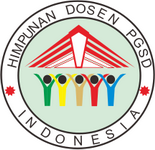ARTICULATE STORYLINE MEDIA FOR CREATIVE THINKING OF LEARNERS ON HUMAN RESPIRATORY SYSTEM MATERIAL IN ELEMENTARY SCHOOL
DOI:
https://doi.org/10.31949/jcp.v11i3.14051Abstract
This research aims to analyze the effectiveness of Articulate Storyline media on the human respiratory system material in Class V of SDN 3 Sukamenak. This study employs a qualitative approach with a Design-Based Research (DBR) method. Data collection techniques include observation, interviews, and questionnaires. The study involved 1 material expert and 1 media expert as validators, 1 classroom teacher as a respondent, and 31 fifth-grade students as participants. The results of the material expert validation showed a percentage of 94.05% in the "very valid" category, while the media expert validation obtained a percentage of 92.5%, also categorized as "very valid." The teacher's response to the media reached 84.62%, indicating a "good" category, while the students' response was 78.87%, also falling into the "good" category. These results indicate that the Articulate Storyline media on the human respiratory system is not only feasible for use as a learning tool but also has strong potential to enhance students' creative thinking skills. This media provides an interactive and engaging learning experience that supports the achievement of learning objectives more effectively.
Keywords:
Articulate Storyline, creative thinking, human respiratory system, interactive learning mediaDownloads
References
Arini, W. & Asmila. (2017). Analisis Kemampuan Berpikir Kreatif pada Materi Cahaya Peserta didik KELAS VIII SMP Xaverius Kota Lubuklinggau. Science and Physics Education Journal (SPEJ), 1 (1): 23-28.
Asyhari, A., & Sa’adah, Q. F. (2022). Pengaruh multimedia articulate storyline 3 terhadap kemandirian belajar peserta didik pada materi keanekaragaman hayati kelas X di MAN 1 Kudus. JEID: Journal of Educational Integration and Development, 2(1), 1–14. https://doi.org/10.55868/jeid.v2i1.113
Febrianti, A. P., Sesanti, N. R., & Gutama, A. (2021). Pengembangan media pembelajaran berbasis multimedia articulate storyline untuk meningkatkan motivasi belajar peserta didik pada materi bangun datar kelas IV SD Universitas PGRI Kanjuruhan Malang. Jurnal Prosiding Seminar Nasional PGSD, 5(1), 588–597. https://conference.unikama.ac.id/artikel/index.php/pgsd/article/view/577
Husna, M. N., Sulistyawati, I., & Pramulia, P. (2022). Pengaruh media aplikasi aticulate storyline 3 terhadap hasil belajar kognitif materi keseimbangan dan pelestarian sumber daya alam peserta didik kelas IV. Jurnal Kewarganegaraan, 6(2), 4255–4261. https://doi.org/10.55904/nautical.v1i2.150
Kurniawan, A., Widodo, A., & Mustika, I. (2023). Studi analisis berpikir kreatif dalam pembelajaran IPA di sekolah dasar. Jurnal Inovasi Pendidikan Dasar, 8(2), 132–140.
Murhaini, Suruansyah. (2016). Menjadi Guru Profesional berbasis Teknologi Informasi dan Komunikasi. Yogyakarta: LaksBang PRESSIndo. Nurfajriani, Siti, H., & Nur, H. (2020). Pengaruh multimedia articulate storyline berbasis discovery learning terhadap kemampuan berpikir kreatif pada materi laju reaksi. Prosiding Seminar Kimia, 75–80.
Nadhiroh, U., & Ahmadi, A. (2024). Pendidikan inklusif: membangun lingkungan pembelajaran yang mendukung kesetaraan dan kearifan budaya. Ilmu Budaya: Jurnal Bahasa, Sastra, Seni, Dan Budaya, 8(1), 11-22.
Nurfajriani, Siti, H., & Nur, H. (2020). Pengaruh multimedia articulate storyline berbasis discovery learning terhadap kemampuan berpikir kreatif pada materi laju reaksi. Prosiding Seminar Kimia, 75–80.
Nurfatimah Sugrah, Implementasi Teori Belajarn Konstruktivisme dalam Pembelajaran Sains, Jurnal Humanika, Kajian Ilmiah Mata Kuliah Umum , 19. No. 02, (2020): 36.
Parwati, N. P. Y., & Pramartha, I. N. B. (2021). Strategi guru sejarah dalam menghadapi tantangan pendidikan indonesia di era society 5.0.
Rahayu, R., Iskandar, S., & Kurniawan, D. T. (2023). Karakteristik keterampilan guru abad 21. Caruban: Jurnal Ilmiah Ilmu Pendidikan Dasar, 6(1), 89-102.
Rahmawati, F., & Atmojo, I. R. W. (2021). Analisis media digital video pembelajaran abad 21 menggunakan aplikasi Canva pada pembelajaran IPA. Jurnal Basicedu, 5(6), 6271–6279. https://doi.org/10.31004/basicedu.v5i6.1717
Sapitri, D & Bentri, A. (2020). Pengembangan Media Pembelajaran Berbasis Aplikasi Articulate Storyline pada Mata Pelajaran Ekonomi Kelas X. Jurnal Inovtech, 1-8.
Setyaningsih, S., Rusjino, & Wahyudi, A. (2020). Pengaruh Penggunaan Media Pembelajaran Berbasis Articulate Storyline Terhadap Motivasi Belajar Dan Hasil Belajar Peserta didik Pada Materi Kerajaan Hindu Budha Di Indonesia. Didaktis: Jurnal Pendidikan dan Ilmu Pengetahuan, 20(2), 144-156. http://dx.doi.org/10.30651/didaktis.v20i2.4772
Sitorus, S., & Retnawati, H. (2022). Profil kemampuan berpikir kreatif siswa sekolah dasar dalam pembelajaran IPA. Jurnal Ilmiah Pendidikan Dasar, 9(1), 15–26.
Widyadari, 22(1), 143-158. Muis, A. A. (2021). Peranan internet sebagai sumber belajar dalam meningkatkan minat belajar Pendidikan Agama Islam peserta didik kelas XI di SMA Muhammadiyah Parepare. Jurnal Al-Ibrah, 10(1), 189-222.
Yudhistira, R., Rifaldi, A. M. R., & Satriya, A. A. J. (2020). Pentingnya perkembangan pendidikan di era modern. Seminar Nasional Bahasa Dan Sastra Indonesia Universitas Muhammadiyah Jakarta (hlm. 1–6). Jakarta
Published
How to Cite
Issue
Section
License
Copyright (c) 2025 Daniaty SR Danial, Ghullam Hamdu, Syarip Hidayat

This work is licensed under a Creative Commons Attribution-ShareAlike 4.0 International License.
Authors who publish with this journal agree to the following terms:
- Authors retain copyright and grant the journal right of first publication with the work simultaneously licensed under a Creative Commons Attribution License that allows others to share the work with an acknowledgment of the work's authorship and initial publication in this journal.
- Authors are able to enter into separate, additional contractual arrangements for the non-exclusive distribution of the journal's published version of the work (e.g., post it to an institutional repository or publish it in a book), with an acknowledgment of its initial publication in this journal.
- Authors are permitted and encouraged to post their work online (e.g., in institutional repositories or on their website) prior to and during the submission process, as it can lead to productive exchanges, as well as earlier and greater citation of published work (See The Effect of Open Access).


